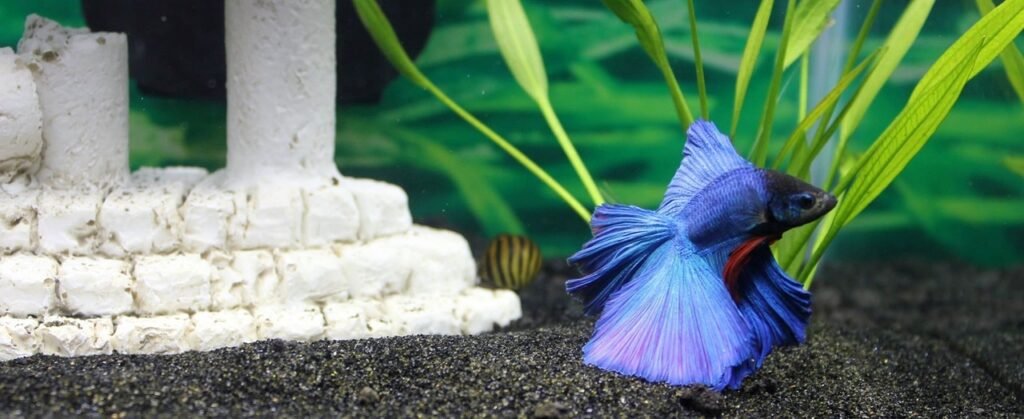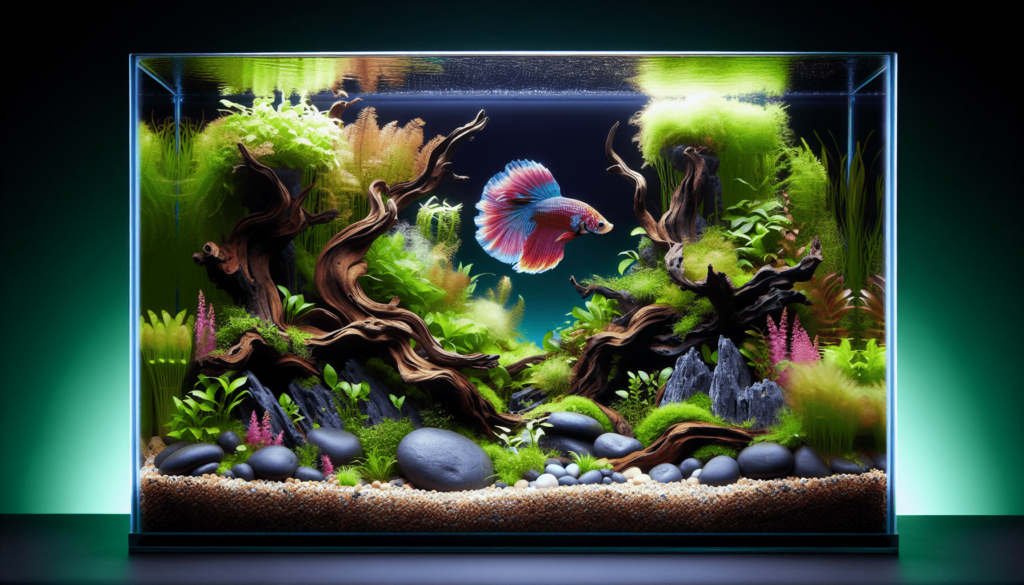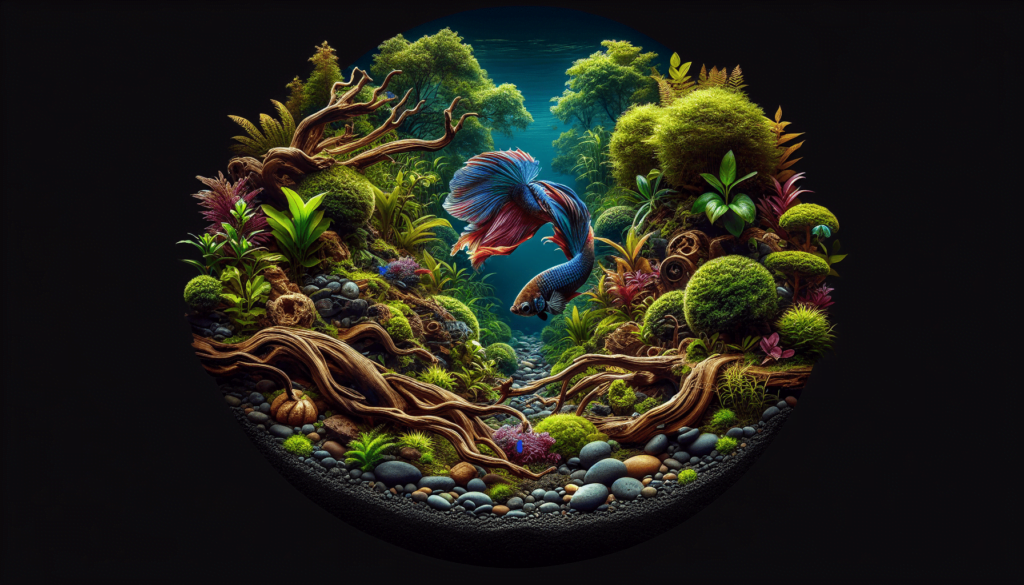In “Mastering Betta Aquascaping: A Comprehensive Guide,” you’ll discover how to create a beautiful and healthy underwater world for your betta fish. Picture a tiny fish tank filled with colorful plants, smooth rocks, and bubbly water all designed just for your finned friend. This guide will take you through every step, from picking the right plants and decorations to the latest trends in fish-tank design. By the end, you’ll be an expert in creating a lovely home that keeps your betta fish happy and healthy.
Mastering Betta Aquascaping: A Comprehensive Guide
Have You Ever Wondered How To Create A Beautiful Home For Your Betta Fish?
Do you know what’s really fun and exciting? Creating a special and beautiful home for your Betta fish! It’s called aquascaping, and it’s like designing a fancy underwater garden just for them. Let’s explore how you can do it and make your Betta fish super happy!
What Is Betta Aquascaping?
Betta aquascaping is all about designing and setting up a lovely environment inside a fish tank for your Betta fish. It’s like making a cozy underwater garden where they can play, hide, and feel safe. This helps them stay healthy and happy. Isn’t that cool?

Why Is Betta Aquascaping Important?
Creating an attractive and comfortable environment for your Betta is very important. It not only looks great, but it also keeps your Betta fish active and engaged. Betta fish love exploring, so adding plants, rocks, and decorations makes their home interesting.
A Quick Look At The History Of Betta Aquascaping
Once upon a time, Betta fish were found in the wild in places like Thailand, Cambodia, and Vietnam. They lived in shallow waters, like rice paddies. People were fascinated by their bright colors and started keeping them as pets. Over time, people realized that creating a beautiful, natural home for Betta fish helped them live better lives.

What’s Trending In Betta Aquascaping Today?
Today, more and more people are interested in making their Betta fish tanks look amazing. Some people even share pictures of their beautiful tanks online! Let’s look at some of the current trends in Betta aquascaping:
- Natural Look: Many people like to create a natural look with real plants, rocks, and driftwood to mimic a Betta’s natural habitat.
- Themed Tanks: Some people design tanks with themes, like “Under the Sea” or “Fairy Garden.” This makes the tank fun to look at.
- Minimalistic Designs: Others prefer a simple and clean look with just a few key decorations.
Key Concepts and Definitions
What is Aquascaping?
Aquascaping is the craft of setting up, arranging, and decorating aquatic environments. It’s like gardening underwater! You use plants, stones, and other elements to create a gorgeous scene in your tank.
Betta Fish Habitat
Betta fish originally live in shallow, slow-moving waters filled with vegetation. Thus, it’s essential to mimic this environment to make your Betta feel at home.
Substrate
The substrate is what you put at the bottom of the tank. It could be gravel, sand, or special planting soil. It helps plants grow and makes the tank look nice.
Filtration
Filtration keeps the water clean. It removes dirt, debris, and harmful chemicals, providing a healthy environment for your Betta.
Lighting
Good lighting helps plants grow and makes the fish tank look vibrant. Extra lighting can also mimic natural sunlight, which Betta fish enjoy.

Getting Started: Setting Up Your Betta Tank
Choosing the Right Tank
Picking the right tank is the first step. A minimum of 5 gallons is recommended for Betta fish. A larger tank gives your Betta more room to swim around and explore.
Adding the Substrate
Next, you need to add the substrate. Gravel, sand, or special aquarium soil can be used. Special planting soil is best if you plan to have live plants.
Installing the Filter and Heater
A filter keeps the water clean, and a heater ensures the water stays warm. Betta fish like water temperatures between 76-82°F.
Setting Up the Lighting
A good light helps plants to grow and displays your Betta’s beautiful colors. Make sure the light you choose is suitable for aquarium use.
Choosing Plants and Decorations
Live Plants vs. Artificial Plants
Live plants are great because they help keep the water clean and provide oxygen. But they need care and good lighting. Artificial plants are easier to manage but don’t offer the same benefits.
| Feature | Live Plants | Artificial Plants |
|---|---|---|
| Oxygen Supply | Yes | No |
| Maintenance | Higher | Lower |
| Natural Look | Authentic | Less Authentic |
| Water Quality | Better | No Impact |
Best Plants for Betta Aquascaping
Some plants are especially good for Betta tanks. Here are a few:
- Java Fern: This plant is easy to care for and doesn’t need special lighting.
- Anubias: Another plant that’s simple to grow. It can be attached to rocks or driftwood.
- Marimo Moss Balls: These are fun, round plants that Betta fish love to play with.
- Amazon Sword: It grows big and provides lots of hiding spots for your Betta.
Adding Decorations
Decorations like rocks, driftwood, and ceramic items can make the tank look amazing and give your Betta places to hide and explore. Just make sure they are safe for aquarium use.
Arranging Your Tank
Now, it’s time to arrange everything in the tank. Start with the substrate, then add the decorations and plants. Place taller plants and decorations at the back and shorter ones in front. This way, your Betta can swim freely and explore all around.

Maintaining Your Betta Tank
Regular Water Changes
Performing regular water changes is crucial. This helps remove waste and keep the water clean. Aim to change about 25% of the water each week.
Checking Water Parameters
Use a water test kit to check the water parameters like pH, ammonia, nitrite, and nitrate levels. Keeping these in the correct range ensures your Betta stays healthy.
| Parameter | Ideal Range for Bettas |
|---|---|
| pH | 6.5-7.5 |
| Ammonia | 0 ppm |
| Nitrite | 0 ppm |
| Nitrate | <20 ppm< />d> |
Pruning Plants
If you have live plants, they will grow over time. Prune them regularly to keep the tank looking neat and to allow light to reach all areas.
Cleaning the Substrate
Use a gravel vacuum to clean the substrate during water changes. This helps remove any waste or uneaten food that has settled at the bottom.
Feeding Your Betta Fish
Choosing the Right Food
Betta fish eat both plants and animals, so they need a balanced diet. You can feed them Betta pellets, flakes, and frozen or live foods like brine shrimp and bloodworms.
Feeding Schedule
Feed your Betta small amounts twice a day. Be careful not to overfeed, as this can make the water dirty and harm your fish.

Understanding Betta Fish Behavior
Recognizing Happy Betta Behavior
A happy Betta is active, with bright colors and spread-out fins. They swim around, explore their tank, and react to your presence.
Signs of Stress or Illness
If your Betta is hiding a lot, has clamped fins, or is losing color, it might be stressed or sick. Keeping their tank clean and maintaining proper water conditions can help prevent this.
Helping Your Betta Relax
Bettas need places to hide and feel safe. Adding caves, plants, and decorations can help them relax and reduce stress.
Advanced Betta Aquascaping
Creating an Aquascaped Scene
For those who want to take it to the next level, designing a full aquascaped scene can be thrilling. This involves advanced planning and creativity. You can create landscapes like forests, mountains, or even underwater ruins.
DIY Decorations
You can create your own decorations using safe materials. For example, you can make caves from PVC pipes or use coconut shells to create hiding spots.
Using CO2 Systems
For advanced plant growth, some aquarists use CO2 injection systems. This helps plants grow faster and look more vibrant but requires more care and monitoring.
Different Perspectives on Betta Aquascaping
Traditional vs. Modern Approaches
Some people prefer a traditional approach by using simple setups with gravel and a few decorations. Others go for modern, highly aquascaped tanks with advanced lighting and CO2 systems.
Natural vs. Themed Tanks
While some enjoy creating a natural habitat similar to the wild environment of Betta fish, others love themed tanks. Each has its own charm and can be a fun project.
| Approach | Key Features | Benefits |
|---|---|---|
| Traditional | Simple setup, basic decorations | Easy to maintain |
| Modern | Advanced aquascaping, CO2 systems | Stunning visuals, plant growth |
| Natural | Mimics natural habitat | Comfortable for Betta |
| Themed | Creative themes, fun elements | Visually appealing, entertaining |
Future Trends In Betta Aquascaping
More Technology Integration
In the future, we might see more technology in Betta tanks, like smart devices to monitor water parameters and automatic feeders.
Eco-Friendly Materials
As awareness grows, using eco-friendly materials and sustainable practices in aquascaping will become more popular.
Enhanced Plant Varieties
Advancements in plant breeding may bring new varieties of aquatic plants that are more colorful and easier to care for.
Why Betta Aquascaping Matters
Creating a beautiful and healthy environment for your Betta is not only fun but also essential for their well-being. It stimulates their natural behaviors, keeps them active, and ensures they live a long and happy life.
Conclusion
Recap
To recap, Betta aquascaping involves creating a beautiful tank environment that mimics the natural habitat of Betta fish. It requires choosing the right tank, substrate, plants, decorations, and maintaining proper water conditions. Understanding Betta behavior and feeding them correctly is also vital.
Final Thought
Imagine your Betta swimming happily around an underwater garden that you created. Doesn’t that sound wonderful?
Engage with Us!
Have you tried Betta aquascaping? Share your experiences, ask questions, or show off your beautiful Betta tanks in the comments below. We can’t wait to see what you create!
Credible Sources
- “Betta Fish Care: The Complete Guide to Caring for and Keeping Betta Fish as Pet Fish,” Jenny Gregory.
- “Aquascaping: Aquarium Landscaping Like a Pro,” George Farmer.
- Websites like Fishkeeping World, The Spruce Pets, and Aquarium Co-op provide valuable insights and guidelines on Betta fish care and aquascaping.



